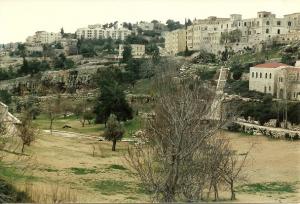Hell: is it a hideous threat, unworthy of our enlightened age? Is hell merely a state of mind that exists only here on earth? Or is hell a sober future reality that we will want to avoid if at all possible, a place for which any notion of “hell on earth” is just a foretaste?
If hell is only here on earth, then it is notoriously unfair, because too many undeserving people suffer it, and too many deserving characters escape it. Which compels us to believe, or at least adds to the plausibility, that there must be a price to pay beyond this life for crimes against the moral order (if one accepts the existence thereof).

Neither time nor polling data can change the truth of whether such a future place of torment exists or not. It is chronological snobbery to insist that hell cannot exist because we are too enlightened to believe in anything so primitive or horrid.
In a day when nothing in the Bible supposedly counts unless it’s in red print (i.e., spoken by Jesus), how can we throw out hell, when Jesus preaches it more than all other voices in Scripture combined? Jesus is the one who uses the name Gehenna for “hell” eleven out of the twelve times the term is used in the New Testament (the twelfth time is by his brother James in James 3:6).
Jesus does not invent Gehenna as a name for hell. The name Ge-Hinnom means “Valley of (the Son of) Hinnom,” the valley on the southwest side of Jerusalem where children were once burned to Molech (Jeremiah 7:31), which becomes a 24/7 pile of burning garbage by the time of Jesus (a colorful image!). The name Gehenna is never used before the New Testament era, but we find it all over the teachings of Jesus’ fellow rabbis.
In addition, Jesus refers to the place where there is “weeping and gnashing of teeth” seven times (no one else does so), and refers to “Hades” three times as the opposite of heaven (in Luke 16, he is referring to a place of overheated torment). Aside from Jesus’ references to hell, the New Testament has four mentions of the lake of fire (Revelation 20:10-15), and one reference to “Tartaros” in the form of a verb “to cast into Tartaros” (2 Peter 2:4). (The Greek version of Proverbs 30:16 contains a stray reference to Tartaros, the Greek place of torment.)
Hell does not truly develop as a Biblical teaching until the New Testament. In the Hebrew Bible, Sheol is the name usually translated “hell.” It is actually the Hebrew name for the underworld, the abode of the dead, a dark, dusty place roughly equivalent to the Greek Hades, which is usually used to translate the term. (Hear John Walton on the subject at https://www.youtube.com/watch?v=7WY6lEV36yI.) Unlike the Greek Hades, however, the Semitic underworld has no punishments, just hopelessness and oblivion for all, regardless of their earthly deeds (see Ecclesiastes 9:10, Isaiah 38:18). There are traces of fiery future punishment in the Hebrew Bible (Isaiah 66:24), but nothing like a developed doctrine of an eternal destiny for the condemned.
The only way to dismiss Jesus’ warnings about hell is to claim that he was just being rhetorical. An honest (rather than wishful) reading of Jesus does not permit this option. Jesus is either using scare tactics, which we would consider to be unethical, or else he is preaching what he considers to be an urgent, truthful warning to us all.
Those who believe Islam to be as American as apple pie and as Christian as Jesus, should take note that the Quran speaks of hell over 200 times by my personal count, usually borrowing the Jewish term “Gehenna” into Arabic. This does not count the Quran’s references to the Hour of Doom. What the Quran says about hell makes the 26 references in the New Testament look mild by comparison. Hell is the place where people drink “scalding water, festering blood, and other putrid things.” (Sura 38:55) “On that day you shall see the guilty bound with chains, their garments blackened with pitch, and their heads covered with flames.” (Sura 14:49) “Hell shall be their couch, and sheets of fire shall cover them.” (Sura 7:41) Here is one issue on which I actually agree with the Quran, although I find its description to be unnecessarily vivid.
The flames of hell do not have to be literal to be real, particularly because when we speak of a world other than our own, we are often forced to use analogical language. Yes, the flames do seem to conflict with the darkness. But when the Bible uses symbols like this, the reality is likely to be more painful than the symbol.
I find it hard to escape the conclusion that hell is a real destination for souls that we should seek to avoid at all costs. To conclude less, fails to do justice to the teaching of Jesus. And if one wishes to play the game of attributing this teaching to the early church rather than Jesus, then one must throw out the parables of the Sheep and the Goats (Matthew 25:31-46), and the Rich Man and Lazarus (Luke 16:19-31), both of which are firmly tied to this teaching.
C.S. Lewis has a compelling picture of hell in his book The Great Divorce. Lewis pictures hell as a dreary place where people keep moving farther and farther away from each other. And when residents of hell get the chance to take a bus tour of heaven, only one person decides to stay. It reminds me of the scene in Revelation 9 where God pours down plagues on unbelievers trying to get them to cry “Uncle!”, yet after all that effort to compel a change of heart in them, we read that they “did not repent” (Revelation 9:20-21).
If not for our belief that hell is to be cut off from the Author of life and love, I could almost picture heaven and hell as if they were the same place. To be in the presence of God would be heaven for some, and hell for others. Imagine: to spend forever with Someone you can’t stand! That would truly be hell.
The Good News about hell is that God in the flesh has gone there in our place, to endure an eternity of hell for every one of us, so that no one would have to go there. Hell is a place we send ourselves, by rejecting the greatest gift of grace ever given.














